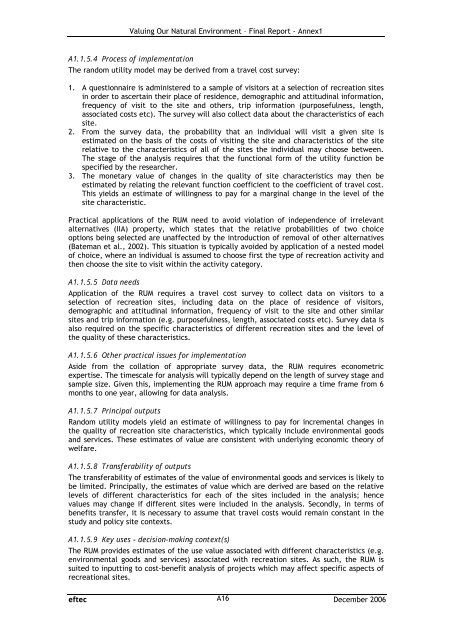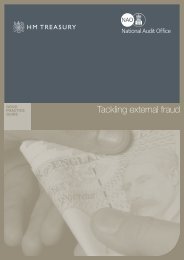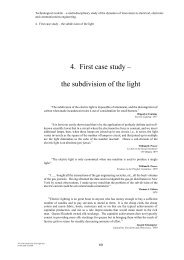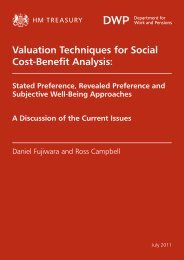Valuing Our Natural Environment Final Report ... - HM Treasury
Valuing Our Natural Environment Final Report ... - HM Treasury
Valuing Our Natural Environment Final Report ... - HM Treasury
You also want an ePaper? Increase the reach of your titles
YUMPU automatically turns print PDFs into web optimized ePapers that Google loves.
<strong>Valuing</strong> <strong>Our</strong> <strong>Natural</strong> <strong>Environment</strong> – <strong>Final</strong> <strong>Report</strong> - Annex1<br />
A1.1.5.4 Process of implementation<br />
The random utility model may be derived from a travel cost survey:<br />
1. A questionnaire is administered to a sample of visitors at a selection of recreation sites<br />
in order to ascertain their place of residence, demographic and attitudinal information,<br />
frequency of visit to the site and others, trip information (purposefulness, length,<br />
associated costs etc). The survey will also collect data about the characteristics of each<br />
site.<br />
2. From the survey data, the probability that an individual will visit a given site is<br />
estimated on the basis of the costs of visiting the site and characteristics of the site<br />
relative to the characteristics of all of the sites the individual may choose between.<br />
The stage of the analysis requires that the functional form of the utility function be<br />
specified by the researcher.<br />
3. The monetary value of changes in the quality of site characteristics may then be<br />
estimated by relating the relevant function coefficient to the coefficient of travel cost.<br />
This yields an estimate of willingness to pay for a marginal change in the level of the<br />
site characteristic.<br />
Practical applications of the RUM need to avoid violation of independence of irrelevant<br />
alternatives (IIA) property, which states that the relative probabilities of two choice<br />
options being selected are unaffected by the introduction of removal of other alternatives<br />
(Bateman et al., 2002). This situation is typically avoided by application of a nested model<br />
of choice, where an individual is assumed to choose first the type of recreation activity and<br />
then choose the site to visit within the activity category.<br />
A1.1.5.5 Data needs<br />
Application of the RUM requires a travel cost survey to collect data on visitors to a<br />
selection of recreation sites, including data on the place of residence of visitors,<br />
demographic and attitudinal information, frequency of visit to the site and other similar<br />
sites and trip information (e.g. purposefulness, length, associated costs etc). Survey data is<br />
also required on the specific characteristics of different recreation sites and the level of<br />
the quality of these characteristics.<br />
A1.1.5.6 Other practical issues for implementation<br />
Aside from the collation of appropriate survey data, the RUM requires econometric<br />
expertise. The timescale for analysis will typically depend on the length of survey stage and<br />
sample size. Given this, implementing the RUM approach may require a time frame from 6<br />
months to one year, allowing for data analysis.<br />
A1.1.5.7 Principal outputs<br />
Random utility models yield an estimate of willingness to pay for incremental changes in<br />
the quality of recreation site characteristics, which typically include environmental goods<br />
and services. These estimates of value are consistent with underlying economic theory of<br />
welfare.<br />
A1.1.5.8 Transferability of outputs<br />
The transferability of estimates of the value of environmental goods and services is likely to<br />
be limited. Principally, the estimates of value which are derived are based on the relative<br />
levels of different characteristics for each of the sites included in the analysis; hence<br />
values may change if different sites were included in the analysis. Secondly, in terms of<br />
benefits transfer, it is necessary to assume that travel costs would remain constant in the<br />
study and policy site contexts.<br />
A1.1.5.9 Key uses – decision-making context(s)<br />
The RUM provides estimates of the use value associated with different characteristics (e.g.<br />
environmental goods and services) associated with recreation sites. As such, the RUM is<br />
suited to inputting to cost-benefit analysis of projects which may affect specific aspects of<br />
recreational sites.<br />
eftec A16<br />
December 2006





![AIRTO [Professor Dr Brian Blunden] - HM Treasury](https://img.yumpu.com/15492848/1/184x260/airto-professor-dr-brian-blunden-hm-treasury.jpg?quality=85)










